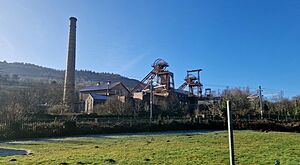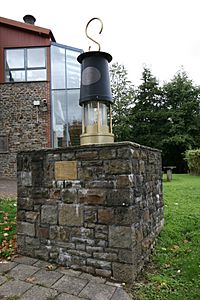Rhondda Heritage Park facts for kids
Rhondda Heritage Park is a fun place to visit in Trehafod, Rhondda, South Wales. It helps people understand what life was like for coal miners in this area until the 1980s. You can even go on a special tour through an old mine shaft at the Lewis Merthyr colliery. Former miners lead these tours, sharing their real-life experiences. Rhondda Heritage Park is also an important part of the European Route of Industrial Heritage (ERIH).
The park is built on the site of the old Lewis Merthyr Colliery. It shows how important coal mining was in the Rhondda Valleys. This area was once one of the biggest coal mining regions in the world. At one time, the Rhondda Valley, which is only about 16 miles long, had more than 53 working coal mines!
Contents
Exploring the History of Lewis Merthyr Colliery
People started digging for coal in the Rhondda as early as the 1600s for their homes. The first official coal mine opened in 1790. Dr. Richard Griffiths was responsible for this and also brought the first tram road to the Rhondda. Later, Walter Coffin opened more pits, which led to the discovery of rich coal seams. Many more railway lines followed to transport the coal.
Early Mines at Lewis Merthyr
Two pits opened in 1850 at what became the Lewis Merthyr site:
- Hafod was opened by two brothers, David and John Thomas.
- Coed Cae was opened by Edward Mills.
Both of these early mines had to close because the working conditions were too difficult.
William Thomas Lewis and the Colliery's Growth
In the mid-1870s, William Thomas Lewis (who later became Lord Merthyr) bought and reopened these two pits. He mined the upper coal seams, which were used for homes. Hafod closed around 1893, and Coed Cae closed in the 1930s.
By 1880, WT Lewis had dug the Bertie shaft. In 1890, he dug the Trefor shaft. Both were named after his sons. By this time, the company was known as the Lewis Merthyr Consolidated Collieries Ltd. It employed about 5,000 men and produced almost a million tons of coal every year. The two tall structures (headframes) and other buildings at the colliery are now protected historic buildings.
Changes and Decline of Coal Mining
In 1904, the company opened the Lady Lewis Colliery about 1 mile to the north east. In 1905, they bought Universal Colliery at Senghenydd. This mine later had the worst mining disaster in British history. In 1929, the colliery became part of the Powell Dyffryn Group. That same year, Coed Cae stopped bringing coal to the surface. Hafod No 2 followed, and Hafod No 1 in 1933. The government took over the colliery in 1947.
In 1958, Lewis Merthyr Colliery joined with the nearby Ty Mawr Colliery. All coal stopped being brought up at Lewis Merthyr. Coal continued to be mined through Ty Mawr, with Lewis Merthyr only used for miners and supplies. By 1969, the mine was called the Ty Mawr/Lewis Merthyr Colliery. Miners used a method called longwall mining to get the coal. Most of the coal was dug out with special tools and loaded onto conveyors by hand.
Until the 1950s, coal mining stayed strong in the area. But after that, fewer and fewer miners were employed. Many pits closed even though there was still coal underground. However, oil and coal from other countries became cheaper. This meant the coal industry in South Wales, including Rhondda, slowly came to an end. At Lewis Merthyr, coal production stopped on March 14, 1983. Mining continued in one section until July, when all coal mining at Ty Mawr/Lewis Merthyr stopped forever.
By 1990, there were no working coal mines left in the Rhondda. Rhondda Heritage Park at the old Lewis Merthyr Colliery now helps us remember this important part of history.
Miner's Lamp Memorial
In May 2000, a 6-foot tall replica of a miner's lamp was placed at the entrance of Rhondda Heritage Park. A plaque on the monument explains that it was built to remember all the miners. It honors those who lost their lives or suffered because of accidents, disasters, or diseases like Coalworker's pneumoconiosis (black lung disease) from working in the mines. A famous actor from Rhondda, Glyn Houston, unveiled the memorial.
Lewis Merthyr Band
The Lewis-Merthyr Band is still active today! It started in or before 1855. The band has won many awards and continues to perform across Wales and beyond. The Lewis-Merthyr Band is thought to be the oldest music group in Rhondda that is still performing.
See also





